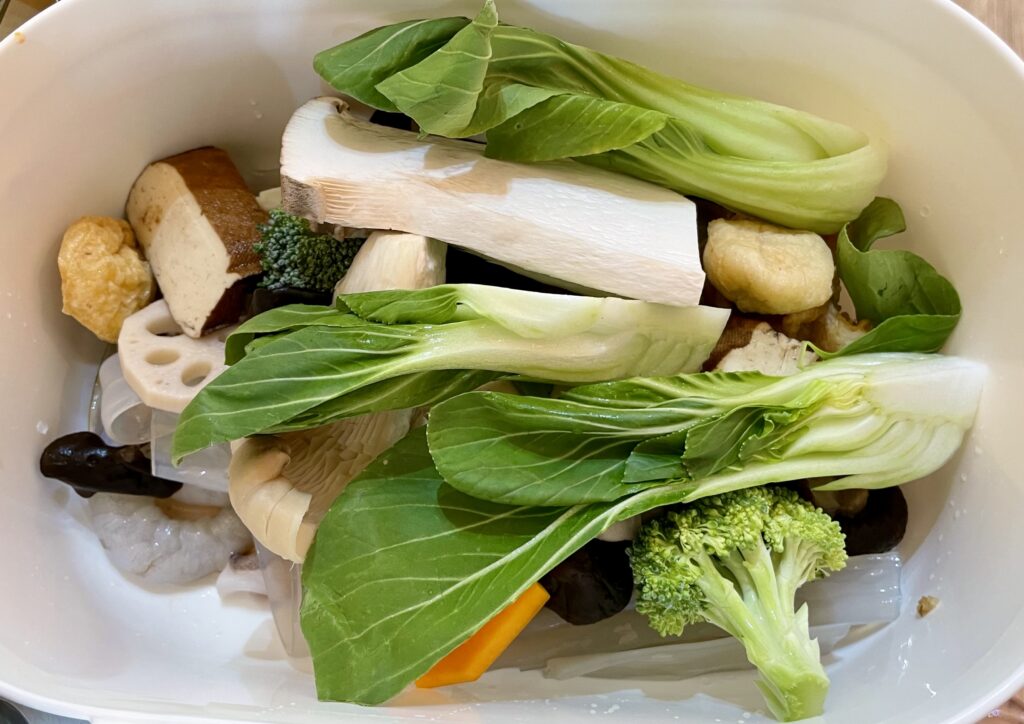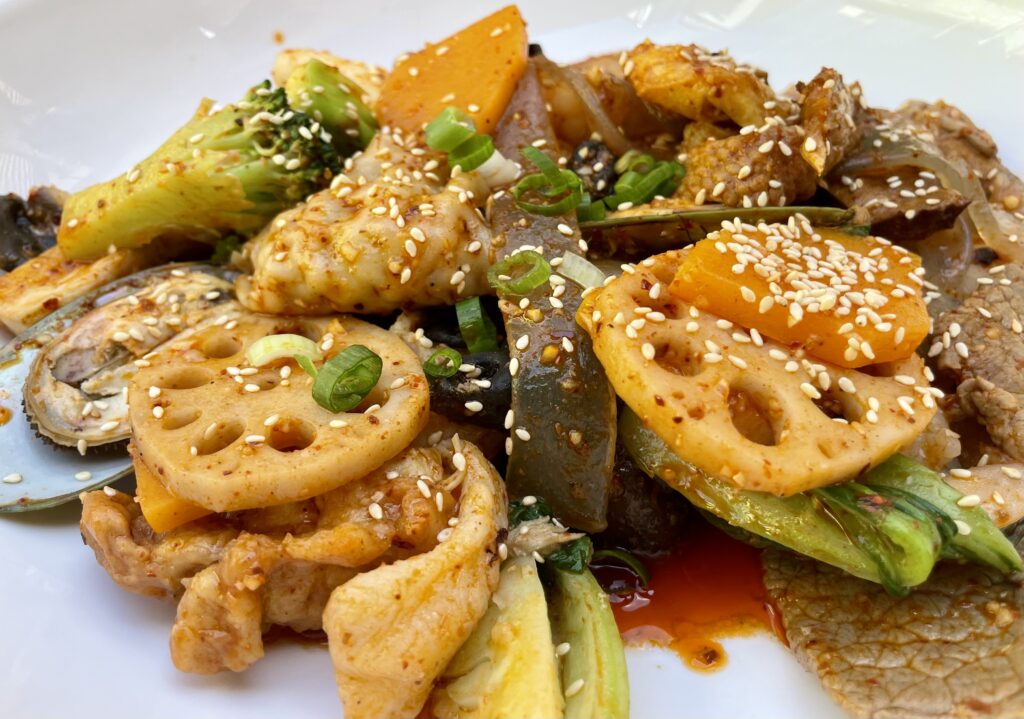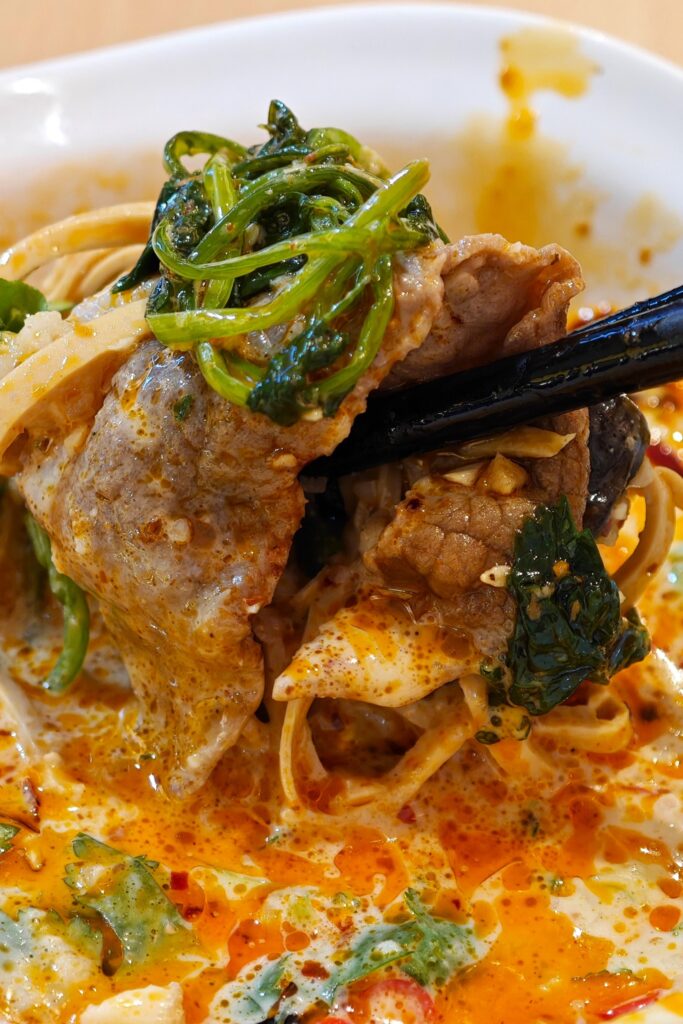Contrary to what the name might suggest, the restaurant Sanku-Maotsai, located just a few minutes’ walk from Frankfurt main station, is not about Maotai or Moutai – a type of baijiu, a traditional Chinese liquor or schnapps. Instead, the name refers to a popular authentic Chinese dish called Maocai (冒菜) from Sichuan Province, known for its spicy and aromatic cuisine.
Restaurant Profile
- Name of the Restaurant: Sanku-Maots’ai
- Adress: Düsseldorfer Str. 13, 60329 Frankfurt am Main
- Style: Chinese Cuisine – Maocai
- Price: around 15 – 25 EUR per Person (incl. Drinks and Tips)
All spices are imported directly from Sichuan to ensure an authentic taste experience. Look out for recurring discount promotions and free side dishes (like chicken feet to try – maybe not everyone’s cup of tea, but a unique experience😊).
Vegetarians are also well catered for at Sanku-Maotsai, with a wide variety of vegetables, mushrooms, tofu, noodles and more.


But what exactly is maocai? This dish is a combination of various ingredients such as meat, fish, seafood, tofu and vegetables cooked in a spicy broth or stir-fried, similar to the famous hotpot or malatang.
Three words, three dishes, and it’s easy to get confused: hotpot, malatang, and maocai. Here’s a quick guide to clear up the confusion:
- Hotpot (some excellent hotpot restaurants in Frankfurt, for example, are Liuyishou and Sen (vietnamese Version)) is an interactive experience where fresh, pre-selected ingredients are cooked together in a large pot – one of the absolute classics of Chinese cuisine.
- Malatang (if you want to learn more about Malatang, you can find a restaurant in Frankfurt here) and Maocai differ from Hotpot mainly in that the ingredients are not cooked together in a broth at the table, but are already prepared in the kitchen and then served.
- With maocai, the differences go a bit further, for example, different spices and sometimes Chinese medicinal herbs are used for the broth, and there is also a “dry” version.
For this restaurant, we want to focus on dry maocai (香辣干拌), which is made by briefly blanching the ingredients and then stir-frying them in a pan with hot sizzling oil, dried chilies, Sichuan peppercorns, garlic and ginger. Soy sauce, rice wine and a little sugar are added.

Everything is mixed well and simmered briefly until the flavors are fully developed and the ingredients are cooked to perfection.


Dry maocai is served hot and is characterized by its pronounced heat and the distinctive, slightly numbing “mala” sensation on the tongue caused by the chilies and Sichuan pepper. It also has a deep, savory umami flavor from the meat, soy sauce, and other flavor-enhancing ingredients.

While ingredients cooked in a broth become tender, juicy, and aromatic, dry maocai retains the original texture of the components: vegetables remain crisp, and meat or seafood develops a firmer, often slightly caramelized surface. Dry Maocai has a more intense and concentrated flavor because the spices and seasonings adhere directly to the ingredients and are not diluted by a broth. It is this combination of bold flavors and varied textures that probably makes the dry version even better for me than the broth-based one …
It is similar in taste to ma la xiang guo (such as what you find at the China Haus in Frankfurt) or gan guo, where the ingredients are also served in a spicy sauce with minimal liquid.
If you still prefer the soups, here is an overview – the following broths are available:
- Spicy soup – traditional Sichuan spicy (经典川味 – jīng diǎn chuān wèi)
- Tomato soup, mild (浓香番茄 – nóng xiāng fān qié)
- Sour soup with sauerkraut – spicy, but slightly milder than the spicy soup (老坛酸菜 – Lǎo tán suān cài)
- Fresh soup with cooked mushrooms, mild (鲜香三鲜 – xiān xiāng sān xiān)


If you are a regular reader of our blog, you are probably already familiar with the following process. Start by grabbing a bowl and tongs at the entrance, then head over to the food station and explore the wide array of ingredients. You’ll find everything a maocai lover could want. This includes various meats (some marinated, meat rolls, meatballs, etc.), seafood and fish, a variety of vegetables (broccoli, carrots, cabbage, pak choi, etc.), mushrooms, tofu, and several types of savory noodles. Fill your bowl with your favorites, then choose your preferred cooking method – we recommend the dry maocai. Alternatively, you can choose from the broths listed above. For a small surcharge of 2 euros per person, you can also order an unlimited rice option.



After placing your order, you will receive a pager. While your maocai is being prepared, you can create your own dipping sauce at the sauce buffet – we’ve covered this in other posts (e.g. Liuyishou in Frankfurt or Haidilao in Wuhan). The base sauces are golden-brown peanut and sesame sauces. We recommend adding garlic, coriander, shallots, and a bit of chili (though you may want to skip the chili since the maocai is already hot). Feel free to experiment and adjust to your taste.


Now that you have hopefully gotten a good impression of the delicious dishes, have fun trying them out and enjoy your meal at Sanku-Maotsai!






